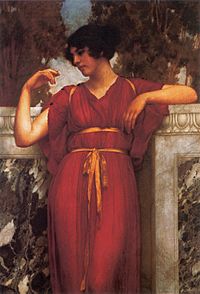Girdle facts for kids
A girdle is like a belt but usually doesn't have a buckle. It's often made from a cord or rope. Girdles were very common in everyday clothing from ancient times up to about the 15th century, especially for women.
Most girdles were practical. They helped hold other clothes in place. But some girdles were loose and worn just for decoration. Rich people sometimes had girdles made with precious metals and jewels.
Today, girdles are still used in some Christian church clothing. The word is also used in American sports for a type of underwear.
The "girdle" as an undergarment is a different idea. This kind of girdle is like a short corset worn around the waist. It became popular in the 20th century. Around 1895, there was also a fashion for "girdles" as a separate part of a dress. These were worn just above the waist over the main dress. They were often about eight inches tall and sometimes had a "V" shape.
History of Girdles
In ancient Greece and Rome, men wore girdles around their waists. These helped hold their tunics in place. They also used girdles to carry a purse, because pockets didn't exist yet! Girls and women wore girdles higher up, under their chest.
Some ancient girdles were ribbons called Strophium, Taenia, or Mitra. You can see these in old artworks. For example, some statues show three cords with a knot, attached to a girdle under the chest. This knot was sometimes shaped like a rose.
Ancient people sometimes called this part of the clothing Succinctorium or Bracile. Both men and women would not wear a girdle when they were in mourning.
If a tunic was very long, it could get tangled around the feet. People would pull the tunic over the girdle to keep it out of the way. This also hid the girdle completely. Sometimes, people wore two girdles at once. One was high up, and the other was low down. This created a puffy look in the tunic between them. This style was mostly for short tunics. Greek men almost always wore a girdle with their tunics.
Among the Anglo-Saxons, both men and women used girdles. Men wore them to hold their tunics and to carry their swords. Some girdles were very fancy, with rich embroidery. Others were made of white leather. Monks often wore a simple leather strap as a girdle.
Girdles in Sports
In American football, players wear a type of girdle under their pants. This girdle holds the hip, thigh, and tailbone pads in place. It also makes it easier to put on the tight football pants.
Older football girdles were like chaps. They only covered the front of the leg with pads that snapped on. Modern girdles are more like tight compression shorts with pockets for the pads.
Girdles were also used in the ancient Mesoamerican ballgame. Today, they are used in sports like hockey (National Hockey League). Some girdles are made specifically for the sport of ringette.



